Gigabyte K8NNXP-940: Built on Athlon64 FX51 Strengths
by Wesley Fink on October 9, 2003 11:52 PM EST- Posted in
- Motherboards
Gigabyte K8NNXP-940: Board Layout
The Gigabyte has one of the best board layouts that you will find with few tradeoffs that can make installation more difficult, and one glaring fault in the layout, which may be unavoidable. The full ATX-size motherboard allows placement of connectors and ports in their best location.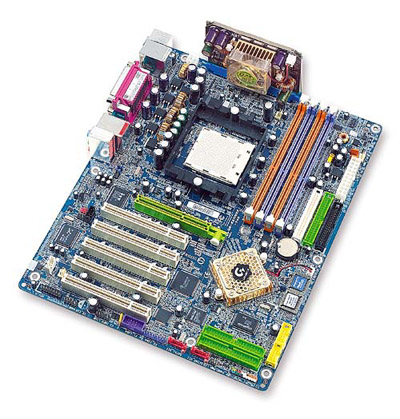
The clear blue board with rounded corners is instantly recognizable as trademark Gigabyte. As you can see, the single-chip nForce3-150 gives designers a little more room for a better board design.
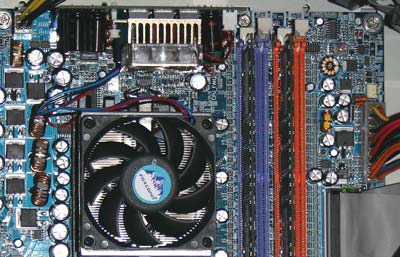
Unlike Athlon XP motherboards, we see a standardized ATX plus 12V connector arrangement on the Athlon64 and FX51 boards we have seen. This is identical to the power connector requirements of current Pentium 4 systems. We generally prefer the connectors together on the upper right of the board, but Gigabyte's placement of the 20-pin ATX to the upper right and the 12V at the top left of the processor socket is acceptable and should allow for decent cable placement.
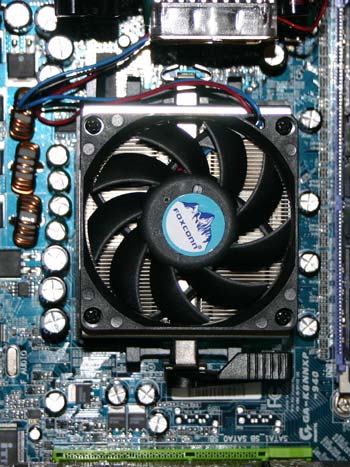
There is plenty of room around the north-to-south sides of the CPU socket, even with the new and much larger Athlon64/64FX heatsink “cage”. Gigabyte has placed the CPU socket away from the top edge to make room for the DPS-K8 power module.
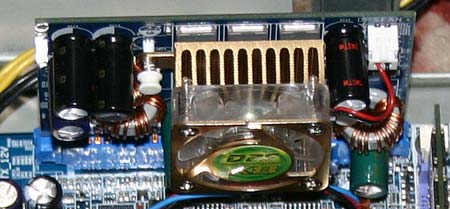
The location of the DPS board on the top edge of the motherboard can be a potential problem in some case designs. It works well in full-tower cases, but many case designs have a downward facing fan to cool the CPU and will be blocked by the DPS-K8 module. With the careful attention to placement of components on the K8NNXP-940, we assume that Gigabyte must have a good reason for choosing this location. You could probably also argue that this location assures the power board stays cool.
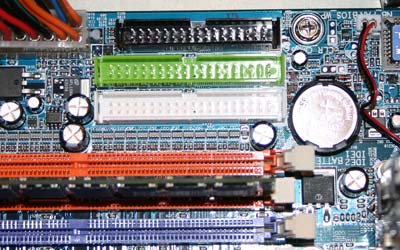
The Floppy connector and Primary/Secondary IDE connectors are all in ideal positions. They are in our preferred position above the midline of the board and to the right of the memory slots. This position on the top right edge of the board works well with cable arrangements in almost any case.
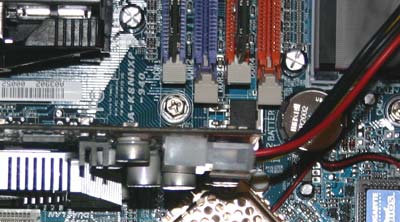
The memory slots are arranged so they do not interfere with the AGP card in any way. Changing or adding memory is easy with this arrangement. Gigabyte also uses their EZ-fix AGP lock, which is one of the better designs for securing the AGP card.










35 Comments
View All Comments
Anonymous User - Tuesday, October 14, 2003 - link
Why would a manufacturer include ECC slots for RAM but no 64 bit PCI bus? Is this aimed at the server market, the high end workstation, or what? Remove two PCI 32 bit slots and make 'em PCI 64bit. You have on board ethernet an USB. All everyone else needs is a video card and you have an AGP slot for that anyway. Come on manufacturers, let's see some damn 64 bit PCI slots already!!!Anonymous User - Tuesday, October 14, 2003 - link
Why would a manufacturer include ECC slots for RAM but no 64 bit PCI bus? Is this aimed at the server market, the high end workstation, or what? Remove two PCI 32 bit slots and make 'em PCI 64bit. You have on board ethernet an USB. All everyone else needs is a video card and you have an AGP slot for that anyway. Come on manufacturers, let's see some damn 64 bit PCI slots already!!!Anonymous User - Tuesday, October 14, 2003 - link
To reiterate and emphasize #19's question:* WHEN will these things become AVAILABLE? *
I've already ordered my FX-51 processor and most of the rest of the system. I'm twiddling my thumbs waiting for this motherboard to appear on the virtual shelves of some reseller.
Maybe I should resort to ball and jacks.
Anonymous User - Monday, October 13, 2003 - link
The anti-AMD comments are completely baseless. So you're going to stop buying from one company because one product is not good? What about the other company's product? Are you going to buy that just because you happened to not have a bad experience with them and then decided to go elsewhere if you do? Such is the attitude of the "all or nothing" extremists. I don't like those people - they tend to have tunnel vision.Let us not forget that purchasing EITHER the P4EE or 64 FX this year is a horrible mistake if you plan to upgrade, unless AMD and intel plan on making higher speed grades for those sockets, which seems unlikely. Combine the price point that could allow one to easily purchase a high-end Dual Socket A system for little more than 5% more performance, and you must ask yourself if what you are doing is really worth it...
The Value-conscious buyer gets a Barton or 2.4C system NOW if they really need to upgrade, or waits out until fall next year if they don't. Remember all the high-end stuff... 300MHz PII Klamath, 600 PIII katmai, 1130 PII Cumine, 2GHz willamette, etc.... all of those are top-end platforms with virtually NO upgrade path whatsoever. Many with them were utterly disappointed as something with more performance and a much shinier upgrade outlook could be purchased a few months later....
We have all made mistakes, due to lack of research and closed-box thinking burned by non-A via chipsets and the like, but please, let's learn....
Anonymous User - Monday, October 13, 2003 - link
The anti-AMD comments are completely baseless. So you're going to stop buying from one company because one product is not good? What about the other company's product? Are you going to buy that just because you happened to not have a bad experience with them and then decided to go elsewhere if you do? Such is the attitude of the "all or nothing" extremists. I don't like those people - they tend to have tunnel vision.Let us not forget that purchasing EITHER the P4EE or 64 FX this year is a horrible mistake if you plan to upgrade, unless AMD and intel plan on making higher speed grades for those sockets, which seems unlikely. Combine the price point that could allow one to easily purchase a high-end Dual Socket A system for little more than 5% more performance, and you must ask yourself if what you are doing is really worth it...
The Value-conscious buyer gets a Barton or 2.4C system NOW if they really need to upgrade, or waits out until fall next year if they don't. Remember all the high-end stuff... 300MHz PII Klamath, 600 PIII katmai, 1130 PII Cumine, 2GHz willamette, etc.... all of those are top-end platforms with virtually NO upgrade path whatsoever. Many with them were utterly disappointed as something with more performance and a much shinier upgrade outlook could be purchased a few months later....
We have all made mistakes, due to lack of research and closed-box thinking burned by non-A via chipsets and the like, but please, let's learn....
Reflex - Monday, October 13, 2003 - link
Heh, K6-2's rocked provided you did your research on your motherboards. The Asus P5A was easily my favorite, I still have a few systems out there that I built based on those and they are *rock* solid. I suppose if you bought a PC Chips board/relabel and had system issues that it may have colored your perspective, but honestly most of the boards I used at the time from Asus, Abit and Epox were all very very good.But its always that way, if you do your homework you won't get burned. Or at least its rare. ;)
Anonymous User - Sunday, October 12, 2003 - link
#26 - I had a comparable mentality as it relates to AMD. I thought the K6-2 was craptastic as well but let me tell you, AMD has come a LONG way since then and most of the problems with the K6-2's were actually with the MB chipsets. If you don't give AMD another look you are selling yourself short. Sure glad I did!Anonymous User - Sunday, October 12, 2003 - link
It's best to leave people like #26 alone as you can't save them. Just like those people who continuously buy from Dell, best to look, shake your head, and keep walking.Reflex - Sunday, October 12, 2003 - link
#26: Never buy once you have had a defective product? How's that i820 motherboard with MTH doing these days? How about the first generation P4 that was slower than the P3? GOt a P60 with the floating point bug? How much money you invest in the dead end called RDRAM? Ever pick up one of those 1.13Ghz P3 CPU's, the first generation ones that had all sorts of problems...With your attitude I am amazed you can buy Intel. After all, they have had practically a parade of errors and flaws. As far as I know no company hits everything 100% all the time. Judging based on your experience with a single product is pretty idiotic, I am certain I can find a very flawed product that was put out by virtually every company in tech at some point or other. But hey, where will you go when you finally end up with a flawed Intel chip, I mean I guess its off to the Via C3 or something...heh.
Anonymous User - Sunday, October 12, 2003 - link
The Macs are really, really, really freaking fast. What are you talking about? The Mac G5 beats a dual 3Ghz Xeon system by about 50% all around.I'll never ever buy a Mac though. Just like I'll never buy an AMD system since my K6-2 fiasco. Say what you want, it left a bad taste in my mouth. I won't shop at Best Buy. I wont buy anything made by Sony either after 2 discmans (men?), a $600 amplifier, and a CD burner broke way too early. After a company sells me a faulty product, I don't buy from them anymore.
Maybe the Pentium Pro pricing days are coming back, but regardless, Intel's new roadmap suggests that by this time next year a 3.6 Ghz Prescott with a 1Mb cache will be in the midrange price range and still fit in any 478-pin socket. That, to me, says that today's best buy is still a P4 2.4C. Who knows if AMD will still be in business by then anyway. Maybe IBM will be tired of giving them 200 million bail-out gifts, and will own them by then.
I will admit this: The best high-end system, for the buck, right now, is certainly AMD. I just won't buy one.